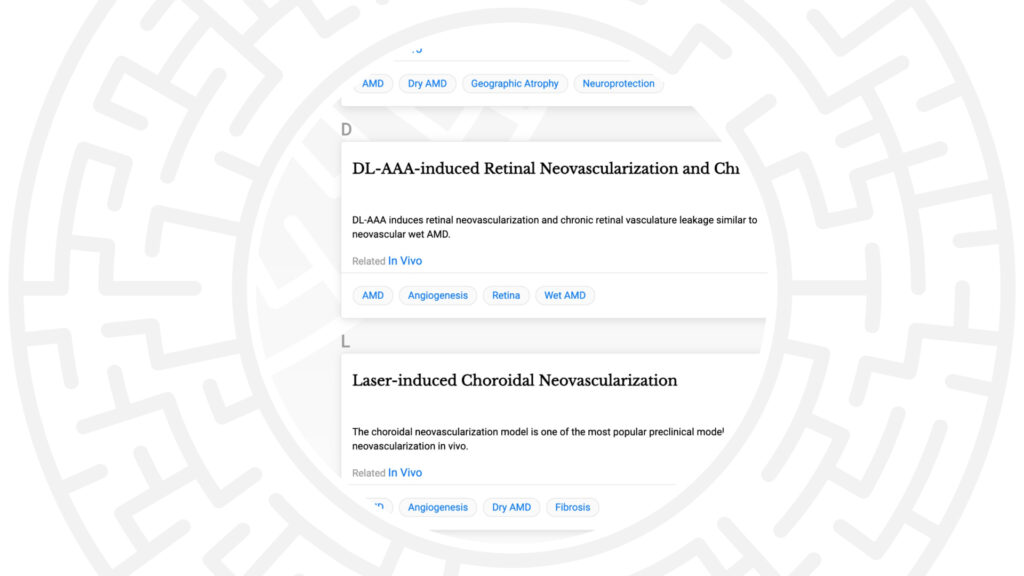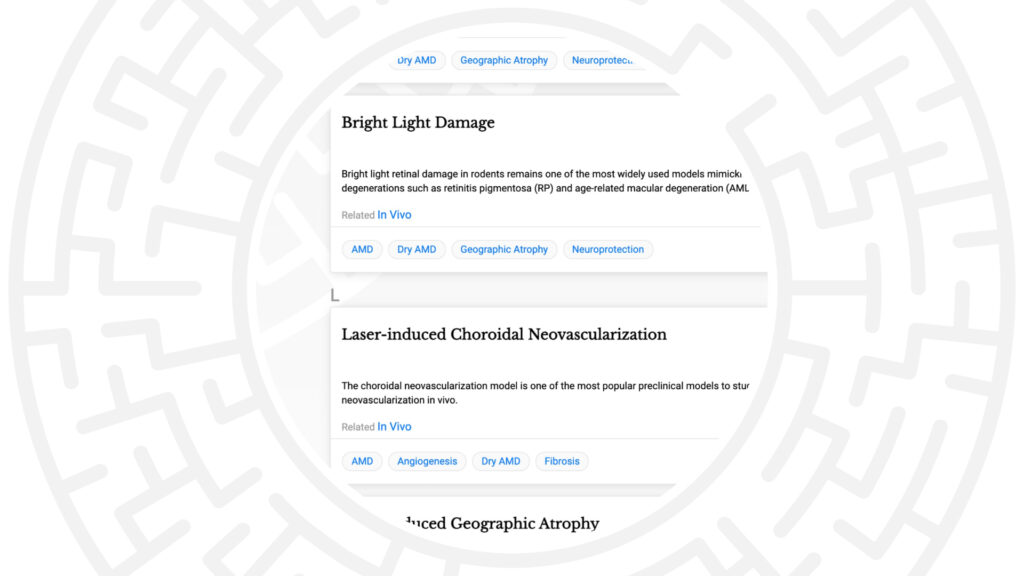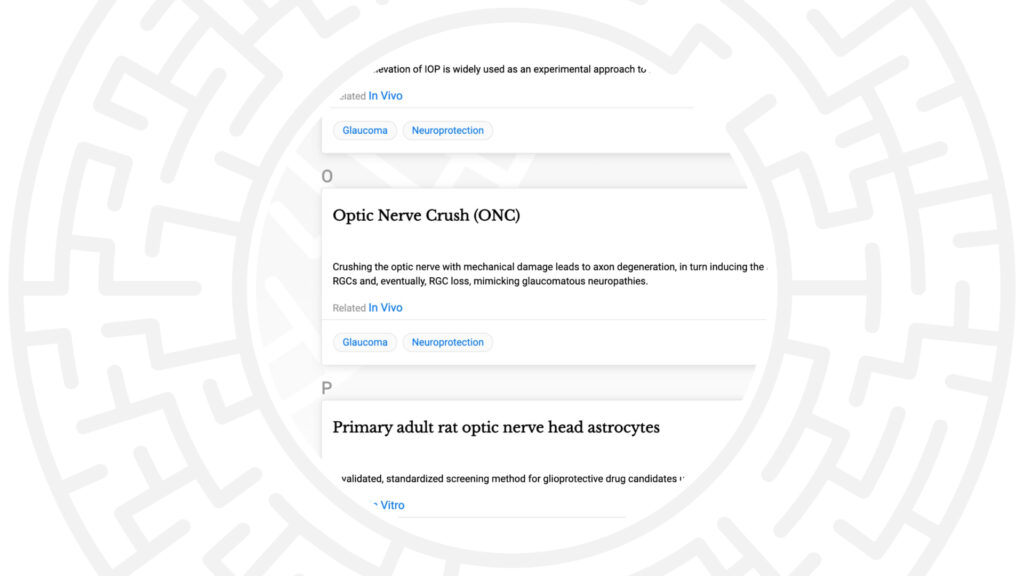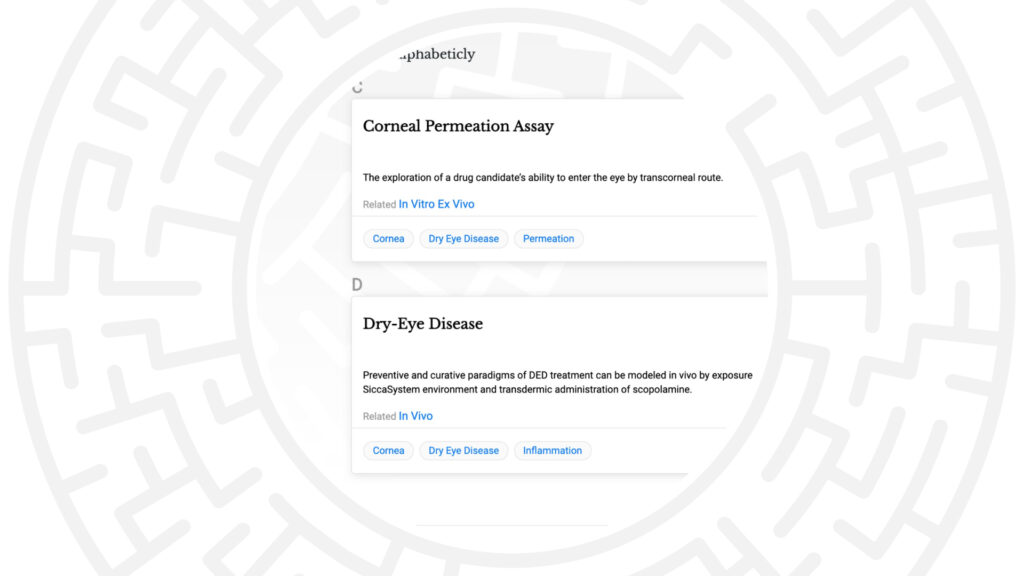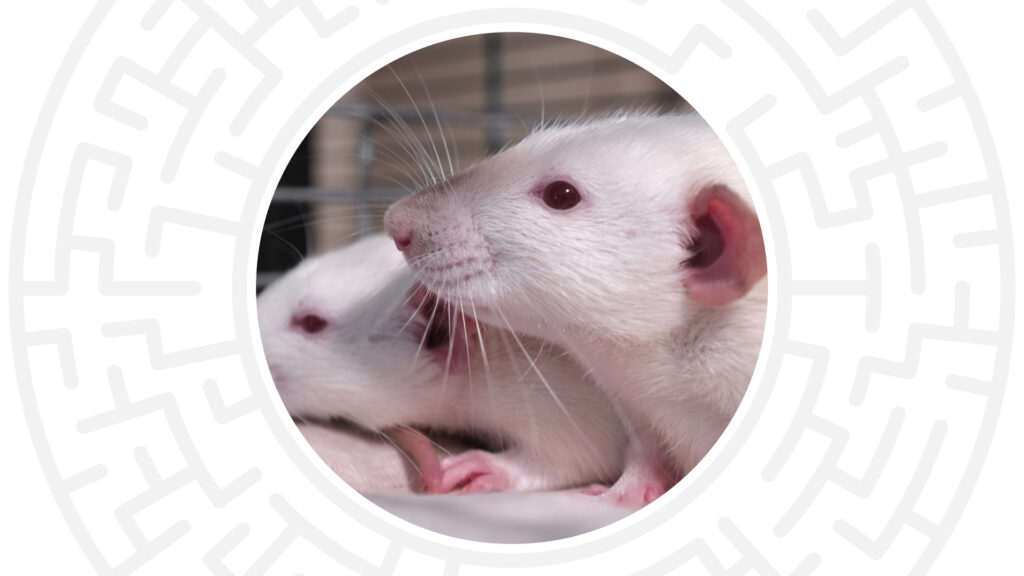Summary: Experimentica is pleased to announce its participation in the annual meeting of the Association for Research in Vision and Ophthalmology (ARVO) 2024.


Content
Experimentica attends ARVO 2024 – follow our Scientists and visit us at booth #1440!
The Association for Research in Vision and Ophthalmology annual meeting is a premier event uniting global experts in eye and vision research. Attendees present and discuss cutting-edge findings across various disciplines, including basic science, clinical research, epidemiology, imaging technologies, genetics, and public health. The meeting serves as a platform for collaboration, knowledge exchange, and professional development, facilitating breakthroughs in understanding vision mechanisms, developing treatments, and promoting eye health worldwide.
At the 2024 ARVO meeting in Seattle, WA (May 5-9, 2024), Experimentica will be presenting its latest R&D findings aimed at improving preclinical research in Ophthalmology. These findings have an impact on our in vitro and in vivo ophthalmic drug discovery models, and are a testament of our teams’ skills and ability to generate bespoke models answering unique, innovative questions.
With more than a decade of experience in the field of Ophthalmology, Experimentica provides a wide range of in vivo and in vitro services, including pharmacology and efficacy studies, PK studies, and safety and toxicology studies.
Our team of experts will be on hand to discuss how our services can help accelerate your research and bring new therapies to patients with ocular diseases such as but not limited to age-related macular degeneration (AMD), diabetic retinopathy, and glaucoma.
We look forward to connecting with fellow researchers and industry professionals at the ARVO meeting this year and sharing our latest scientific insights and capabilities in ophthalmic research.
Presented by Experimentica Ltd.
Do not miss out on our team’s abstracts in physiopathology and preclinical model development.
A B S T R A C T
Validating injectable anesthesia for the streptozotocin-induced diabetic retinopathy rat model.
332 – B0538 | 8:00 AM – 9:45 AM PT on Sunday, May 5, 2024
Presenter: Anni Tenhunen
Authors: Tenhunen A, Tähtivaara L, Koskenniemi H, Koponen AM, Lappeteläinen B, Partanen P, Ekolle X, Mering S, Voipio HM, Cerrada-Gimenez M
Purpose: Streptozotocin (STZ) induced hyperglycemic rats, commonly used in preclinical diabetic retinopathy (DR) research, have poor response to the most used laboratory rodent anesthesia such as medetomidine/ketamine mixture (MK), and are prone to develop various welfare issues. The purpose of this study was to compare medetomidine/midazolam/butorphanol anesthesia (MMB) to MK in the STZ induced DR rat model to validate injectable anesthesia with less side effects and faster recovery time without compromising the DR development.
A B S T R A C T
Optimization of iPSC-RPE oxidative stress model to be used as screening tool for novel AMD drug discovery.
194 – B0191 | 8:00 AM – 9:45 AM PT on Sunday, May 5, 2024
Presenter: Jenni J. Hakkarainen, PhD
Authors: Ghosh AK, Kolehmainen A, Vergun O, Hakkarainen JJ
Purpose: The purpose of this study was to optimize a method of oxidative stress induction in inducible pluripotent stem cell-derived retinal pigment epithelial cells (iPSC-RPE) and test the cytoprotective effect of the antioxidant, Mn(III)TMPyP. This model mimics early AMD changes in the RPE and will serve as a screening tool to identify lead candidates to treat AMD.
A B S T R A C T
Dose-dependent Retinal Damange in a LED White Bright Light Model.
758 – B0259 | 1:00 PM – 2:45 PM PT on Sunday, May 5, 2024
Presenter: Marc Cerrada-Gimenez, PhD
Authors: Cerrada-Gimenez M, Tähtivaara L, Tenhunen A, Ekolle X, Lappeteläinen B, Jokinen V, Haapaniemi AM, Koponen AM, Partanen P, Kolehmainen A, Kvietkauskiene N, Bijeikis S, Vähätupa M, Jamison J
Purpose: The current study was performed to evaluate the feasibility to design a white bright light damage system using more efficient LEDs capable of inducing photoreceptor degeneration in a dose dependent manner.
A B S T R A C T
Comparative Evaluation of Anti-Angiogenic Effects of Biosimilar Drugs in a DL-α-Aminoadipic Acid Rabbit Model of Chronic Vascular Leakage in Retina.
712 – B0213 | 1:00 PM – 2:45 PM PT on Sunday, May 5, 2024
Presenter: Donatas Neverauskas, PhD
Authors: Neverauskas D, Cesna R, Ragauskas S, Paulauskas T, Kalesnykas G, Jamison J, Adamoniene O
Purpose: Compare the impact of biosimilar drugs – bevacizumab, aflibercept, brolucizumab, ranibizumab, and farcizumab – on retinal structure and function in the rabbit DL-AAA model.
A B S T R A C T
Neural Network-based Isolectin B4 Flat-Mount Analysis in a Novel AAV-hVEGF-Induced Diabetic Retinopathy Animal Model.
2333 – A0187 | 3:00 PM – 4:45 PM PT on Monday, May 6, 2024
Presenter: Inesa Lelyte
Authors: Lelyte I, Ragauskas S, Dragasius M, Ahmed Z, Kalesnykas G, Kvietkauskiene N
Purpose: Diabetic retinopathy (DR) is a complex disease displaying diverse vascular-associated complications, including upregulation of vascular endothelial growth factor (VEGF)-A enhanced retinal angiogenesis, and neovascularization. Current animal models do not fully replicate the spectrum of DR pathologies. In this study, we aim to evaluate the efficacy of adeno-associated virus (AAV)-mediated long-term expression of human VEGF to establish angiogenic DR-related phenotypes in Brown Norway rats, as well as validate a novel artificial intelligence (AI) framework for autonomous quantification of retinal angiogenesis in a newly established DR model.
A B S T R A C T
Synthetic peptide hydrogel-based human in vitro corneal model.
4476 – A0195 | 10:30 AM – 12:15 PM PT on Wednesday, May 8, 2024
Presenter: Dovilė Litvinavičiūtė, PhD
Authors: Litvinavičiūtė D, Urbanaviciute J, Jelinskas T, Mazetyte-Godiene A, Cepla V, Aldonyte R, Hakkarainen JJ
Purpose: Synthetic peptide hydrogels are promising scaffolds where cornea epithelium and other cell types can be grown into in vitro cultures. The aim of this study was to develop a corneal model employing a peptide hydrogel layer as a mimetic of corneal stroma. The model was used in the assessment of corneal cytotoxicity and penetration properties of prostaglandin analogs that are considered as first-line treatment for glaucoma.
A B S T R A C T
Bacterial Cell Wall Component Induced Uveitis in Brown Norway Rats.
5614 – B0014 | 8:00 AM – 9:45 AM PT on Thursday, May 9, 2024
Presenter: Austin Brown
Authors: Brown A, Bacellar-Galdino M, Pappenhagen NE, Arnold J, Thomas B, Jamison J
Purpose: Uveitis describes the inflammation of the uveal tissues of the eye. Posterior uveitis, the inflammation of the choroid, can affect the retina and optic nerve and result in blindness. Lipopolysaccharide (LPS) is routinely used to induce a phenotype of infectious uveitis in rabbits. However, descriptions of the LPS-induced uveitis models differ in the literature. The purpose of this study is to characterize the LPS-induced model for infectious uveitis in pigmented Brown Norway rats using LPS derived from Escherichia coli, Salmonella typhimurium, Pseudomonas aeruginosa, and explore the effects of Peptidoglycan (PG) from Staphylococcus aureus.
A B S T R A C T
Function-Structure Relationship in the Rat Glaucoma Model.
6758 – B0957 | 2:00 PM – 3:45 PM PT on Thursday, May 9, 2024
Presenter: Kernius Mickevičius
Authors: Mickevicius K, Paulauskas T, Cesna R, Dragasius M, Urbanaviciute J, Ragauskas S, Kalesnykas G
Purpose: Examining the link between retinal function and structure in ocular hypertension is crucial for glaucoma research. The rat magnetic microbead model, mimicking glaucoma aspects, provides insights into this relationship. The study aims to examine if behavioral, functional, and morphological parameters have correlation in the rat magnetic microbead glaucoma model.
A B S T R A C T
Comparison and Efficacy Of Two Endodontic Paper Brands to Measure Mouse Tear Production.
6550 – B0237 | 2:00 PM – 3:45 PM PT on Thursday, May 9, 2024
Presenter: Juliette Arnold
Authors: Arnold J, Bacellar-Galdino M, Pappenhagen NE, Brown A, Jamison J
Purpose: Zone quick phenol red threads have previously been the gold standard for measuring aqueous tear volume in rodent studies of dry eye disease (DED). This product is no longer available outside of Japan due to changes in the supply chain after the COVID pandemic. A new method is necessary to measure tear volume in rodents. Even though the use of endodontic paper points (EPP) was published before, the methods has not been well validated. In this study we compare the efficacy and reliability of two brands and two sizes of EPP to measure tear volume in rodents, and a benzalkonium chloride (BAK) model of DED.
Meet with us in Seattle
Whether you have a question about our science, preclinical models, capabilities, pricing or anything else, our senior management and business development team is ready to answer your inquiries.


Giedrius Kalesnykas, PhD
President and Chief Executive Officer
Dr. Kalesnykas has extensive research experience in eye research and neuroscience developing neuronal-based projects at the University of Eastern Finland and The Wilmer Eye Institute, The Johns Hopkins University, MD, USA. For more info visit Giedrius’ profile page or LinkedIn.


Guillaume Demarne, PharmD
Chief Business Officer
Dr. Demarne has been leading and involved in pharmaceutical operations, fundraising, licensing, and business development for 15 years at international research institutes, biotech start-ups, and pharmaceutical companies in Europe, the US, and China. For more info visit Guillaume’s profile page or LinkedIn.


Jenni J. Hakkarainen, PhD
Chief Operating Officer
Dr. Hakkarainen has a strong research background in ex vivo and in vitro drug permeability testing and prediction of drug transport across biological barriers, such as cornea, blood-brain barrier, intestine, and skin. For more info visit Jenni’s profile page or LinkedIn.


Jeff Jamison, PhD
Chief Development Officer
Dr. Jamison is an ophthalmic researcher with degrees in Electrical and Biomedical Engineering. He worked at Pfizer and Alcon before founding Ophthy-DS, a preclinical CRO specializing in ocular toxicology and disease modeling acquired by Experimentica in 2020. More info on Jeff’s profile page or LinkedIn.


Marc Cerrada-Gimenez, PhD
Chief Technology Officer
Dr. Cerrada-Gimenez is an accomplished scientist with extensive experience in in vitro and in vivo modeling in Ophthalmology and neurodegeneration. He manages the development and implementation of innovative technologies to optimize Experimentica’s preclinical research capabilities. For more info visit Marc’s profile page or LinkedIn.



